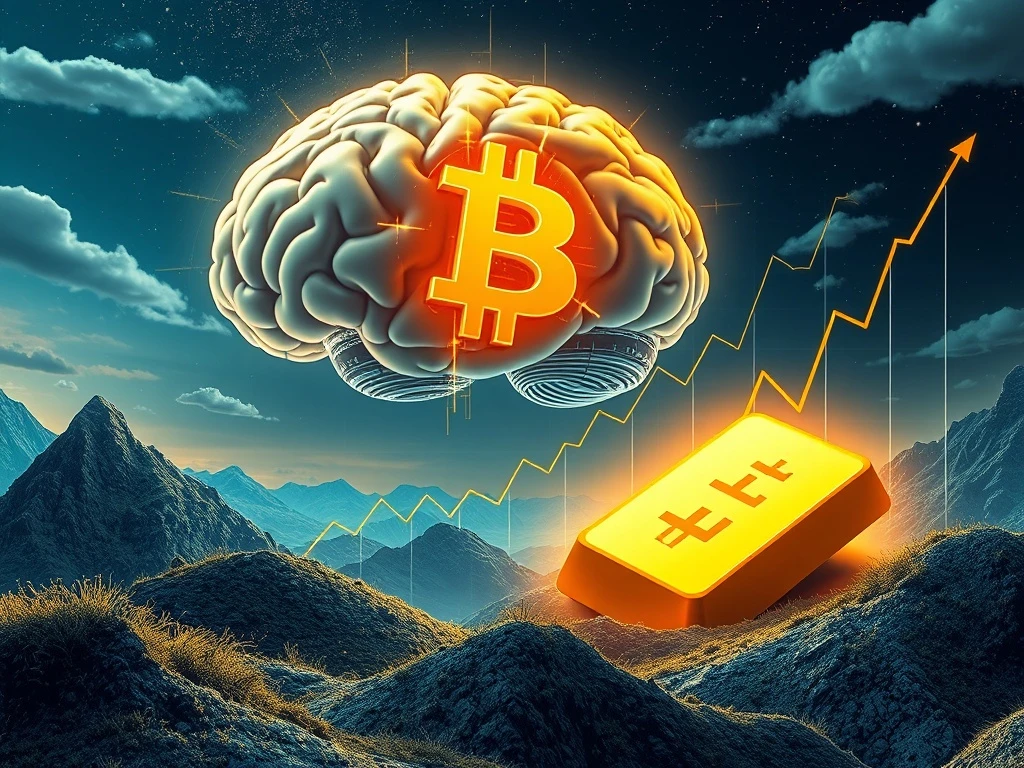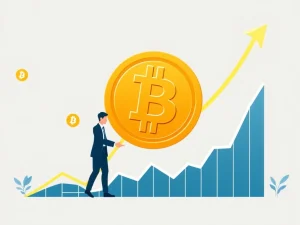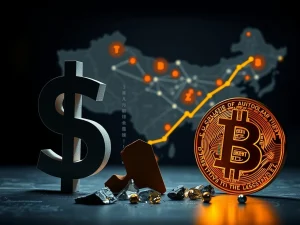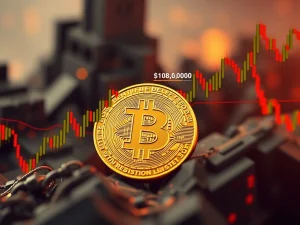Bitcoin Unleashed: AI-Driven GDP Projections Challenge Gold as Bitcoin Surges 80%

The financial world is in flux, with traditional investment wisdom being rapidly rewritten. Imagine a scenario where a long-time crypto skeptic like Jim Cramer not only reverses his stance but actively recommends Bitcoin. This isn’t fiction; it’s today’s reality. As national debts swell and AI-driven forecasts paint a picture of unprecedented economic shifts, investors are scrambling to understand what comes next. The very notion of a ‘safe haven’ asset is being challenged, leading many to question the long-term stability of their portfolios. Is the surging Bitcoin Price a signal of a new era, or just another speculative bubble?
Bitcoin Price: A Surging Digital Hedge?
For years, Jim Cramer was a vocal skeptic of cryptocurrency. Yet, in a remarkable pivot, he recently advocated for Bitcoin as a hedge against potential monetary devaluation. His reasoning? Growing concerns over U.S. fiscal health. This marks a significant shift from his 2022 dismissal of crypto, reflecting a broader unease about traditional asset stability. Bitcoin’s impressive 80% annual return has undoubtedly bolstered its appeal as a digital inflation hedge. While its relative youth still makes its long-term viability speculative for some, its performance in this volatile environment has many re-evaluating its role.
Consider these key points regarding Bitcoin’s current position:
- Jim Cramer’s Endorsement: A surprising vote of confidence from a mainstream financial commentator.
- Inflation Hedge Appeal: Bitcoin’s strong performance amid inflation concerns highlights its perceived value.
- High Returns: An 80% annual return outpaces many traditional assets significantly.
AI Impact: Reshaping Economic Outlooks
Beyond market speculation, a powerful new force is emerging: Artificial Intelligence. Researchers at Epoch AI propose a transformative scenario where even modest automation of economically useful tasks—say, 30% by 2030—could propel annual GDP growth to an astonishing 20%. Such an acceleration would fundamentally alter the investment landscape. This potential AI Impact on productivity and economic expansion is a game-changer. If these projections hold, assets historically considered safe havens, like gold (which is up 40% year-to-date) and even land, could become less attractive, especially if rising interest rates climb as high as 20% and erode their value.
The implications of such rapid AI-driven growth are profound:
- Unprecedented GDP Growth: AI could unlock new levels of economic productivity.
- Challenge to Traditional Assets: High growth and high rates could diminish the appeal of gold and land.
- Investment Re-evaluation: Investors must adapt strategies for a hyper-growth environment.
Gold vs Bitcoin: The Shifting Investment Landscape
The debate over asset allocation has never been more intense. On one side, we have the prospect of AI-driven economic acceleration; on the other, the specter of prolonged monetary instability. Gold, a perennial safe haven, has seen a respectable 40% gain year-to-date. However, Bitcoin’s 80% surge dwarfs this. This stark contrast highlights the core tension in today’s markets: do you bet on a future of unprecedented productivity gains, or do you hedge against potential monetary debasement?
A diversified portfolio, historically, might include gold, Bitcoin, and land to protect against monetary debasement. However, as The Breakdown suggests, this strategy risks underperforming if AI-driven productivity gains materialize as projected. The dilemma is clear: capital returns could skyrocket in an AI boom, but asset values tied to a shrinking physical economy—consider land in aging populations like Japan’s—might become obsolete. The traditional “Gold vs Bitcoin” debate is evolving into a broader discussion about asset relevance in a technologically advanced future.
Understanding Current Market Trends
Amidst these grand economic shifts, current Market Trends reveal a fascinating mix of euphoria and underlying stability. Speculative trading volumes in meme stocks and volatile equities have reached historic highs, driven by online communities making Reddit-fueled bets on companies like Dunkin Donuts and Kohl’s. Goldman Sachs data confirms that speculative stock trading now constitutes an unusually large share of total market activity, a trend often associated with market euphoria rather than foundational stability.
However, this speculative fervor coexists with more stable indicators:
- Real Wage Growth: The Atlanta Fed’s wage tracker shows real wage growth outpacing inflation by 4.2%.
- AI and Employment: The FT reports that generative AI has not yet led to significant job displacement in high-risk sectors, easing some fears.
This dichotomy underscores the complex nature of the current market, where rapid technological advancement meets traditional economic indicators.
Navigating the Future Economic Outlook
The uncertainty extends to macroeconomic policy, with a surreal public debate between figures like Donald Trump and Federal Reserve Chair Jerome Powell over U.S. fiscal policy. This lack of consensus highlights the challenge of navigating a post-labor economy, where traditional economic models may no longer apply. Further complicating the picture is research from Anthropic on AI’s “inverse scaling”—where extended processing time can lead to poorer outcomes—raising questions about the reliability of both human and machine decision-making in an era of rapid technological change.
Despite these complexities, some indicators suggest cautious optimism for the Economic Outlook:
- Recession Odds: Polymarket traders now price the odds of a U.S. recession this year at a low 18%, down from earlier highs.
- Q3 Growth Projections: U.S. economic growth for Q3 is on track for 2.4%, with some analysts even hinting at a staggering 24% expansion if AI-driven productivity truly surges as expected.
The path ahead remains uncertain, forcing both policymakers and investors to adapt to an environment where the rules are constantly being rewritten.
Conclusion: Embracing the Unpredictable Future
The financial landscape is undergoing a monumental transformation, driven by the twin forces of AI innovation and shifting monetary policy. From Jim Cramer’s surprising embrace of Bitcoin to the potential for AI to unlock unprecedented GDP growth, the investment world is brimming with both opportunity and challenge. Traditional safe havens are being re-evaluated, speculative markets are reaching new heights, and the very nature of economic stability is being redefined. Navigating this era requires not just an understanding of past trends, but a forward-looking perspective, embracing diversification and adaptability. Whether you’re eyeing the soaring Bitcoin Price or re-assessing your long-term Economic Outlook, staying informed and flexible will be key to thriving in this brave new financial world.
Frequently Asked Questions (FAQs)
1. Why did Jim Cramer change his stance on Bitcoin?
Jim Cramer, a long-time cryptocurrency skeptic, reversed his stance primarily due to growing concerns over U.S. fiscal health and national debt. He now views Bitcoin as a potential hedge against monetary devaluation, recommending it as a protective asset in a volatile economic environment.
2. How could AI significantly impact global GDP?
Researchers like those at Epoch AI suggest that even modest automation of economically useful tasks (e.g., 30% by 2030) could lead to unprecedented annual GDP growth rates, potentially reaching 20%. This is because AI can dramatically increase productivity and efficiency across various sectors, fundamentally altering economic output.
3. Is Bitcoin a better investment than gold right now?
While gold has seen a respectable 40% year-to-date return, Bitcoin has surged by 80% in the same period. Bitcoin is increasingly seen by some as a digital inflation hedge, particularly in an environment of high interest rates that can erode the value of traditional assets like gold. However, Bitcoin’s volatility and relative youth mean its long-term viability is still considered speculative by some, making the choice dependent on individual risk tolerance and investment goals.
4. What are the key risks of investing in today’s market?
Today’s market presents several risks, including high national debt, potential monetary devaluation, and the speculative nature of certain assets (like meme stocks). While AI offers potential for hyper-growth, there’s also uncertainty regarding its impact on job displacement and the reliability of AI decision-making. Investors face the dilemma of choosing between assets that benefit from a hyper-growth scenario versus those that protect against monetary debasement.
5. What is ‘inverse scaling’ in AI, and why is it relevant?
‘Inverse scaling,’ as researched by Anthropic, refers to a phenomenon where extended processing time or increased model size in AI can sometimes lead to poorer rather than improved outcomes. This concept is relevant because it raises questions about the inherent limitations and reliability of both human and machine decision-making in an era of rapid technological change, adding a layer of complexity to future economic and policy decisions.








